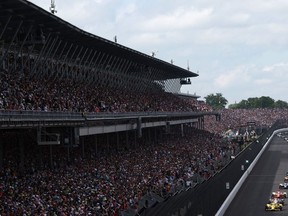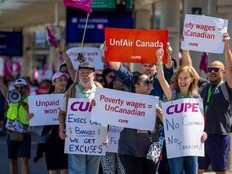Italian race team Prema wants to take on American IndyCar racing

Article content
Americans won the first two Indy 500s in US-made cars. Then, in 1913, French driver Jules Goux took first in a Peugeot. As if to hammer home the European victory, during the hot race conditions he used champagne to rinse out his mouth.
Plenty of foreign drivers have since had success in IndyCar racing, including current Spanish champion Alex Palou. But since 1996, when IndyCar launched teams in a shift to professionalize the sport, European teams have scraped barely a handful of victories.
Prema Racing, based in Vicenza, Italy, is the latest to try to take on American racing on their own turf. Co-founded 41 years ago by Angelo Rosin and three other employees, the company now has roughly 220 employees across five racing leagues in Europe, after decades of dominating the leagues where future Formula 1 drivers learn their craft.
“We were looking for something bigger,” said Rene Rosin, Prema’s team principal and son of founder, during an interview at the first IndyCar race of the season in St. Petersburg, Florida. “We cover everything from karting till the door of Formula One. We wanted to give another chance to our drivers, mechanics, and engineers.”
It’s unclear why European teams have struggled in IndyCar. UK-based Carlin Motorsport, now known as Rodin, entered the IndyCar feeder system in 2015. Three years later, they were racing with two cars in the top division. By the 2021 season, the team had only secured one pole position ever and no wins. They sold their assets at the end of that year to Juncos Hollinger, an Argentine-American racing team.
One theory is that Europeans haven’t done a good enough job adapting to the oval race track, according to John Oreovicz, a motorsport journalist and author.
“You think, how hard can it be to drive around in circles?” Oreovicz said. “But in terms of setting the car up and how you drive the car, it’s a very, very specific talent and not everybody adapts to it quickly.”
Prema is not the only European-linked team. UK-based McLaren Racing completed its buyout of Arrow McLaren – formerly Schmidt Peterson Motorsports – earlier this year, and already found some success. But Prema is the only recent European team to start its attempt from scratch.
Prema’s headquarters are in a small town not far from Venice. In June of 2024, they started construction on a base in Indiana, roughly 20 miles away from the Indianapolis Motor Speedway. An investment of over $5 million has been made in facilities over 100,000 square feet, with 50 full time staff members.
It’s a sizable investment in a sport that has struggled over the past few decades. A split between the Indy Racing League and Championship Auto Racing Teams in 1996 fractured racing in the US. The two groups reunited in 2008, but racing remains dominated by Nascar and now F1 in the US.
Billionaire Roger Penske bought the IndyCar series in 2019, and almost immediately faced the Covid-19 pandemic. The series slowly picked up viewers, with the 2023 season being the most-watched IndyCar campaign since 2011.

Like F1, there are engine usage limits in place, with cars built around the same rules since 2012. Penske Entertainment has regularly discussed changing the rules for 2027, in the hope to make the races more exciting. IndyCar also has a new broadcast partner in Fox this year, after over 20 years with NBCUniversal. The first race of the season this year had an audience of 1.4 million viewers, the most-watched race outside the Indy500 since 2011.
The numbers of the Fox deal have not been released, but their previous media rights deals with NBC over the span of years from 2009 to 2024 all totaled $180 million a year with the last six years having an annual pay out of $20 million. That is lower than the rights for WNBA and National Women’s Soccer League and less than 2% of Nascar’s new deal with multiple partners for an annual total of $1.1 billion.
The Penske ownership has grown the audience and economic base, said Oreovicz, but added sponsorships deals aren’t what they used to be. “There’s no real money changing hands. It’s all business to business relationships.”
After sponsorship and media rights deals, motorsport teams rely on prize money from races to boost their revenue throughout the season. However, IndyCar recently stopped giving out money for individual races, outside the Indy 500 that still boasts a purse of over $18,000,000. Instead, a Leaders Circle Club pays an annual fee of $1.1 million to the top 22 finishers of the season.
The charter guarantee a place on the 33-car starting grid. When the program was started in 2024, IndyCar gave out 25 charters. Prema is not yet eligible. IndyCar CEO Mark Miles confirmed teams are allowed to sell their charters to other teams, making it like any other physical asset they could buy or sell.
Race Day
The first race of the season, the Firestone Grand Prix of St. Petersburg, is held on the edge of Tampa Bay. On the other side of the finish line, team owners park their luxury yachts, alongside Penske’s $120 million boat.
There were over 100,000 fans in attendance at the event over the three-day event. Many wore Formula 1 gear as well as IndyCar merch, with a significant number wearing the orange of Arrow McClaren. Few were wearing the Italian green, white and red of Prema, but the team’s hospitality suite had fans curious about the sport’s latest entrant.

“If you are entering our hospitality, our music already tends to be Italian which I love.” Rosin said about bringing in their culture. “I want to bring professionalism and excellence but also as well fun. Because if you’re not enjoying when you’re doing something in dark moments the fun part helps you get out of it.”
So far, Prema will need to bring the fun. Qualifying on Saturday was tough. Robert Shwartzman, one of Prema’s drivers who began karting at the age of four, found himself at the back of the grid. Callum Ilott, Prema’s British driver, also struggled. In the race he was able to make it up to 8th place but was unable to recover after a pitstop. Both drivers finished the weekend in the bottom half of the pack, Ilott finishing at 19th and Shwartzman in 20th.
“We’ve had in some ways, a lot of preparation and a lot of time and in other ways, no time with no preparation” Ilott said after Saturday qualifying. “It’s not easy to make up for years and years of lack of experience and time with IndyCar compared to some of the other teams in only four days.”
Prema’s CEO is aware that it will take time to get the results that they want.
“I certainly couldn’t speak about why the others weren’t successful,” said Piers Phillips, CEO of Prema Racing. “I think for us it’s about expertise. It’s about experience and it’s about the right culture and the right sort of drive to understand all the challenges. In a nutshell we identified that, yes we want to do things differently.”
After two races into the season, Shwartzman sits at 22st in the rankings with Ilott 25th. They are now heading into the pinnacle of the season concluding with the Indianapolis 500 on May 25th.
“It’s not a one year journey, we have a long journey ahead of us. Of course it will be a challenge but I think we can do a good job.” Rosin said.
Check out our sports section for the latest news and analysis. Care for a wager? Head to our sports betting section for news and odds.











Postmedia is committed to maintaining a lively but civil forum for discussion. Please keep comments relevant and respectful. Comments may take up to an hour to appear on the site. You will receive an email if there is a reply to your comment, an update to a thread you follow or if a user you follow comments. Visit our Community Guidelines for more information.